Analys
OPEC lämnar produktionen oförändrad

![]() Förra veckan skickade vi ut en rapport med förutsättningarna inför OPEC mötet. Vi argumenterade för sannolikheten att OPEC skulle låta produktionen fortsätta oförändrad på 30 Mbpd. Igår fick vi beskedet från Wien, OPEC fortsätter producera mot sitt tidigare mål och man vidtar inga åtgärder för att stärka disciplinen inom gruppen. Marknaden kommer nu hamna i överskott under första halvåret och priset kommer falla ytterligare. Brentoljan föll 6,6 % igår och vi har påbörjat en ny era för oljemarknaden. Femton år av stigande pris har nu abrupt nått sitt slut.
Förra veckan skickade vi ut en rapport med förutsättningarna inför OPEC mötet. Vi argumenterade för sannolikheten att OPEC skulle låta produktionen fortsätta oförändrad på 30 Mbpd. Igår fick vi beskedet från Wien, OPEC fortsätter producera mot sitt tidigare mål och man vidtar inga åtgärder för att stärka disciplinen inom gruppen. Marknaden kommer nu hamna i överskott under första halvåret och priset kommer falla ytterligare. Brentoljan föll 6,6 % igår och vi har påbörjat en ny era för oljemarknaden. Femton år av stigande pris har nu abrupt nått sitt slut.
Stor uppmärksamhet kring OPEC-mötet i Wien
Oljeminstrarna och deras delegationer samlas i stora salen i OPEC:s huvudkvarter i Wien. De ger presentationer av marknadsläget och drar sig sedan undan till ett eget rum där förhandlingarna kring produktionskvoten sker. När en överrenskommelse har nåtts ger de en intervju till media och sedan följer en presskonferens där analytiker och journalister får ställa frågor.
OPEC är en unik organisation. Inom OPEC finns inga svurna fiender eller vänner. Det finns bara ett gemensamt intresse för olja. Denna gång räckte inte det intresset till för att hindra oljepriset från att falla.
Nästa OPEC-möte förlades till den 6:e juni 2015. Det tyder på att OPEC är komfortabel med sitt beslut. Med ett möte i slutet av februari kunde OPEC först observerat prisutvecklingen under den säsongsmässigt starkare efterfrågan under vintern och sedan korrigerat produktionen inför det svagare andra kvartalet. Nu är det uppenbart att OPEC har valt att låta USA:s skifferproducenter reglera produktionen i takt med att de blir olönsamma.
Marknaden ska balansera produktionen – Inte OPEC
Saudiarabien gjorde precis vad de har sagt i upprinnelsen till gårdagens möte – låter marknaden och priset reglera produktionen – inte Saudiarabien och inte OPEC. Under de senaste veckorna har det kommit en uppsjö av estimat för produktionskostnaden av skifferolja i USA. Vi håller oss till den vy vi presenterade i förra veckans rapport ”USA-OPEC: 1-0” där vi argumenterar för att lejonparten tål priser ner mot WTI 65 USD/fat, där risken ligger på nedsidan när många, om inte de flesta, producenter är skyddade av hedgar under nästkommande sex månader. Marknaden ska nu gå till en punkt då tillväxttakten och produktionen i USA:s skifferfält verkligen minskar. Ingen vet var den punkten ligger.
Saudiarabien bestämde agendan I Wien
Det finns en mycket enkel förklaring till vad som hände i Wien: Den marknadsandel som Saudiarabien prioriterar i längden finns i Asien. Den asiatiska marknaden kommer bära upp hela tillväxten i efterfrågan det kommande decenniet. Saudiarabien har förlorat marknadsandelar i USA under 2014, samtidigt som konkurrensen om marknaden i Kina har ökat. Ryssland, Irak och Iran strider alla för sin del av kakan och ingen av dem skulle deltagit i en produktionsminskning, varför Saudiarabien skulle bära risken för alla prishöjande minskningar av produktionen.
Saudiarabien överger sin roll som oljekran
Utsikterna för USA: skifferproducenter har fått Saudiarabien att överge sin roll som swing producent, för att istället fokusera på sin egen marknadsandel. De övriga elva medlemmarna i OPEC har förlitat sig på Saudiarabiens intresse att minska produktionen när priset gått för lågt. Samtidigt har de övriga ofta valt att själva fortsätta producera i samma takt. Saudiarabien vill inte längre ge upp marknadsandelar för att hjälpa de övriga OPEC-medlemmarna. Landet har stora monetära reserver och USA:s skifferproducenter har dykt upp som en ny pålitligt swing producent i marknaden.
Capex and opex kan inte betalas med Amex
Nu kommer breakevenkostnader att hamna i fokus och det är värt att påtala skillnaderna mellan skifferproducenter och konventionella oljeproducenter. Investeringskostnaden, capex + rörlig produktionskostnad, opex motsvarar produktionskostnaden för ett nytt fält. Dessa mått inkluderar prospektering, utveckling och drift och är inte relevant för prisgolv. I det korta perspektivet (1-3 år) är det opex som sätter prisgolvet före produktionen verkligen börjar minska. Så länge opex har täckning kommer producenterna fortsätta att pumpa. Det är därför som producenternas hedgar är så viktiga när priserna börjar falla. Marknaden överraskas så gott som alltid över vilka låga priser som producenterna kan utstå, men även för högkostnadsfält som Kanadas oljesand där capex+opex kan vara omkring 90 usd/fat är opex endast 30 usd/fat. Djuphavsfält med en capex+opex i samma härrad kan ha opex på omkring 40 usd/fat.
Skiffer är annorlunda
Skifferfälten har en mycket mindre skillnad mellan capex och opex. Det betyder att skillnaden mellan priserna som ger incitament att öka investeringar och att minska produktionen ligger närmare varandra. Produktionen av skifferolja karaktäriseras också av skarpt vikande produktion redan andra året. I genomsnitt är produktionen endast 40 % av år ett under andra året. Produktionen kommer därför snabbt att anpassa sig till rådande pris. Den finansiella strukturen för skifferolja gör den till en ideal swing producent som kommer fylla alla Saudiarabiens behov av en aktör som begränsar marknadens totala produktion.
Analys
’wait and see’ mode

So far this week, Brent Crude prices have strengthened by USD 1.3 per barrel since Monday’s opening. While macroeconomic concerns persist, they have somewhat abated, resulting in muted price reactions. Fundamentals predominantly influence global oil price developments at present. This week, we’ve observed highs of USD 89 per barrel yesterday morning and lows of USD 85.7 per barrel on Monday morning. Currently, Brent Crude is trading at a stable USD 88.3 per barrel, maintaining this level for the past 24 hours.

Additionally, there has been no significant price reaction to Crude following yesterday’s US inventory report (see page 11 attached):
- US commercial crude inventories (excluding SPR) decreased by 6.4 million barrels from the previous week, standing at 453.6 million barrels, roughly 3% below the five-year average for this time of year.
- Total motor gasoline inventories decreased by 0.6 million barrels, approximately 4% below the five-year average.
- Distillate (diesel) inventories increased by 1.6 million barrels but remain weak historically, about 7% below the five-year average.
- Total commercial petroleum inventories (crude + products) decreased by 3.8 million barrels last week.
Regarding petroleum products, the overall build/withdrawal aligns with seasonal patterns, theoretically exerting limited effect on prices. However, the significant draw in commercial crude inventories counters the seasonality, surpassing market expectations and API figures released on Tuesday, indicating a draw of 3.2 million barrels (compared to Bloomberg consensus of +1.3 million). API numbers for products were more in line with the US DOE.
Against this backdrop, yesterday’s inventory report is bullish, theoretically exerting upward pressure on crude prices.
Yet, the current stability in prices may be attributed to reduced geopolitical risks, balanced against demand concerns. Markets are adopting a wait-and-see approach ahead of Q1 US GDP (today at 14:30) and the Fed’s preferred inflation measure, “core PCE prices” (tomorrow at 14:30). A stronger print could potentially dampen crude prices as market participants worry over the demand outlook.
Geopolitical “risk premiums” have decreased from last week, although concerns persist, highlighted by Ukraine’s strikes on two Russian oil depots in western Russia and Houthis’ claims of targeting shipping off the Yemeni coast yesterday.
With a relatively calmer geopolitical landscape, the market carefully evaluates data and fundamentals. While the supply picture appears clear, demand remains the predominant uncertainty that the market attempts to decode.
Analys
Also OPEC+ wants to get compensation for inflation

Brent crude has fallen USD 3/b since the peak of Iran-Israel concerns last week. Still lots of talk about significant Mid-East risk premium in the current oil price. But OPEC+ is in no way anywhere close to loosing control of the oil market. Thus what will really matter is what OPEC+ decides to do in June with respect to production in Q3-24 and the market knows this very well. Saudi Arabia’s social cost-break-even is estimated at USD 100/b today. Also Saudi Arabia’s purse is hurt by 21% US inflation since Jan 2020. Saudi needs more money to make ends meet. Why shouldn’t they get a higher nominal pay as everyone else. Saudi will ask for it

Brent is down USD 3/b vs. last week as the immediate risk for Iran-Israel has faded. But risk is far from over says experts. The Brent crude oil price has fallen 3% to now USD 87.3/b since it became clear that Israel was willing to restrain itself with only a muted counter attack versus Israel while Iran at the same time totally played down the counterattack by Israel. The hope now is of course that that was the end of it. The real fear has now receded for the scenario where Israeli and Iranian exchanges of rockets and drones would escalate to a point where also the US is dragged into it with Mid East oil supply being hurt in the end. Not everyone are as optimistic. Professor Meir Javedanfar who teaches Iranian-Israeli studies in Israel instead judges that ”this is just the beginning” and that they sooner or later will confront each other again according to NYT. While the the tension between Iran and Israel has faded significantly, the pain and anger spiraling out of destruction of Gaza will however close to guarantee that bombs and military strifes will take place left, right and center in the Middle East going forward.
Also OPEC+ wants to get paid. At the start of 2020 the 20 year inflation adjusted average Brent crude price stood at USD 76.6/b. If we keep the averaging period fixed and move forward till today that inflation adjusted average has risen to USD 92.5/b. So when OPEC looks in its purse and income stream it today needs a 21% higher oil price than in January 2020 in order to make ends meet and OPEC(+) is working hard to get it.
Much talk about Mid-East risk premium of USD 5-10-25/b. But OPEC+ is in control so why does it matter. There is much talk these days that there is a significant risk premium in Brent crude these days and that it could evaporate if the erratic state of the Middle East as well as Ukraine/Russia settles down. With the latest gains in US oil inventories one could maybe argue that there is a USD 5/b risk premium versus total US commercial crude and product inventories in the Brent crude oil price today. But what really matters for the oil price is what OPEC+ decides to do in June with respect to Q3-24 production. We are in no doubt that the group will steer this market to where they want it also in Q3-24. If there is a little bit too much oil in the market versus demand then they will trim supply accordingly.
Also OPEC+ wants to make ends meet. The 20-year real average Brent price from 2000 to 2019 stood at USD 76.6/b in Jan 2020. That same averaging period is today at USD 92.5/b in today’s money value. OPEC+ needs a higher nominal price to make ends meet and they will work hard to get it.
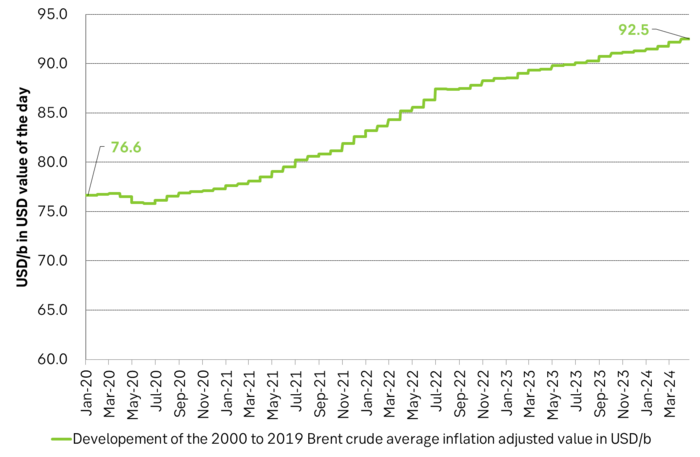
Inflation adjusted Brent crude price versus total US commercial crude and product stocks. A bit above the regression line. Maybe USD 5/b risk premium. But type of inventories matter. Latest big gains were in Propane and Other oils and not so much in crude and products

Total US commercial crude and product stocks usually rise by 4-5 m b per week this time of year. Gains have been very strong lately, but mostly in Propane and Other oils

Last week’s US inventory data. Big rise of 10 m b in commercial inventories. What really stands out is the big gains in Propane and Other oils
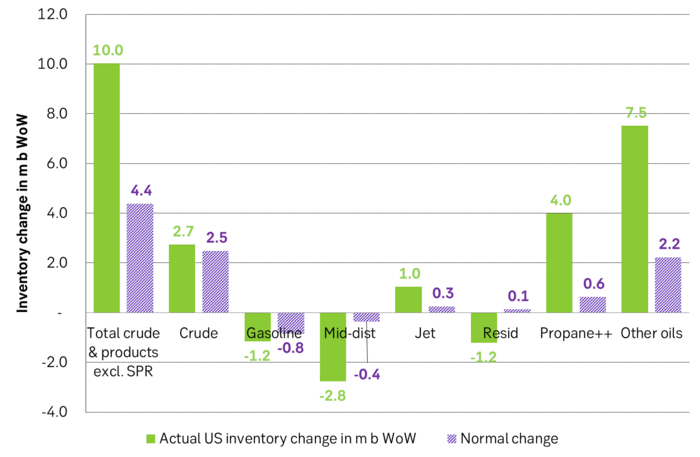
Take actual changes minus normal seasonal changes we find that US commercial crude and regular products like diesel, gasoline, jet and bunker oil actually fell 3 m b versus normal change.

Analys
Nat gas to EUA correlation will likely switch to negative in 2026/27 onward

Historically positive Nat gas to EUA correlation will likely switch to negative in 2026/27 onward

Historically there has been a strong, positive correlation between EUAs and nat gas prices. That correlation is still fully intact and possibly even stronger than ever as traders increasingly takes this correlation as a given with possible amplification through trading action.
The correlation broke down in 2022 as nat gas prices went ballistic but overall the relationship has been very strong for quite a few years.
The correlation between nat gas and EUAs should be positive as long as there is a dynamical mix of coal and gas in EU power sector and the EUA market is neither too tight nor too weak:
Nat gas price UP => ”you go black” by using more coal => higher emissions => EUA price UP
But in the future we’ll go beyond the dynamically capacity to flex between nat gas and coal. As the EUA price moves yet higher along with a tightening carbon market the dynamical coal to gas flex will max out. The EUA price will then trade significantly above where this flex technically will occur. There will still be quite a few coal fired power plants running since they are needed for grid stability and supply amid constrained local grids.
As it looks now we still have such overall coal to gas flex in 2024 and partially in 2025, but come 2026 it could be all maxed out. At least if we look at implied pricing on the forward curves where the forward EUA price for 2026 and 2027 are trading way above technical coal to gas differentials. The current forward pricing implications matches well with what we theoretically expect to see as the EUA market gets tighter and marginal abatement moves from the power sector to the industrial sector. The EUA price should then trade up and way above the technical coal to gas differentials. That is also what we see in current forward prices for 2026 and 2027.
The correlation between nat gas and EUAs should then (2026/27 onward) switch from positive to negative. What is left of coal in the power mix will then no longer be dynamically involved versus nat gas and EUAs. The overall power price will then be ruled by EUA prices, nat gas prices and renewable penetration. There will be pockets with high cost power in the geographical points where there are no other alternatives than coal.
The EUA price is an added cost of energy as long as we consume fossil energy. Thus both today and in future years we’ll have the following as long as we consume fossil energy:
EUA price UP => Pain for consumers of energy => lower energy consumption, faster implementation of energy efficiency and renewable energy => lower emissions
The whole idea with the EUA price is after all that emissions goes down when the EUA price goes up. Either due to reduced energy consumption directly, accelerated energy efficiency measures or faster switch to renewable energy etc.
Let’s say that the coal to gas flex is maxed out with an EUA price way above the technical coal to gas differentials in 2026/27 and later. If the nat gas price then goes up it will no longer be an option to ”go black” and use more coal as the distance to that is too far away price vise due to a tight carbon market and a high EUA price. We’ll then instead have that:
Nat gas higher => higher energy costs with pain for consumers => weaker nat gas / energy demand & stronger drive for energy efficiency implementation & stronger drive for more non-fossil energy => lower emissions => EUA price lower
And if nat gas prices goes down it will give an incentive to consume more nat gas and thus emit more CO2:
Cheaper nat gas => Cheaper energy costs altogether, higher energy and nat gas consumption, less energy efficiency implementations in the broader economy => emissions either goes up or falls slower than before => EUA price UP
Historical and current positive correlation between nat gas and EUA prices should thus not at all be taken for granted for ever and we do expect this correlation to switch to negative some time in 2026/27.
In the UK there is hardly any coal left at all in the power mix. There is thus no option to ”go black” and burn more coal if the nat gas price goes up. A higher nat gas price will instead inflict pain on consumers of energy and lead to lower energy consumption, lower nat gas consumption and lower emissions on the margin. There is still some positive correlation left between nat gas and UKAs but it is very weak and it could relate to correlations between power prices in the UK and the continent as well as some correlations between UKAs and EUAs.
Correlation of daily changes in front month EUA prices and front-year TTF nat gas prices, 250dma correlation.
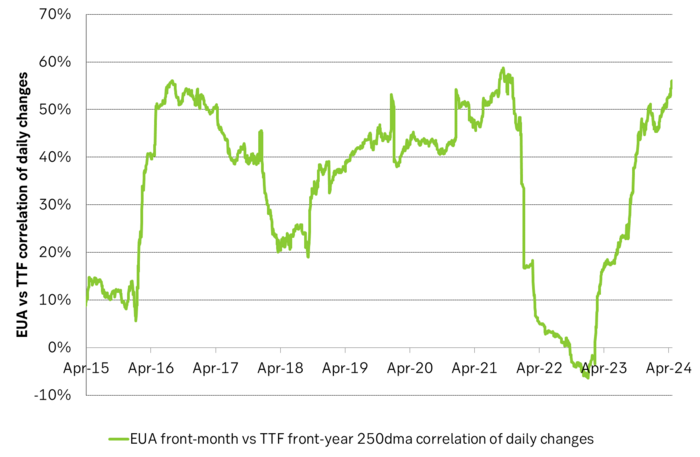
EUA price vs front-year TTF nat gas price since March 2023
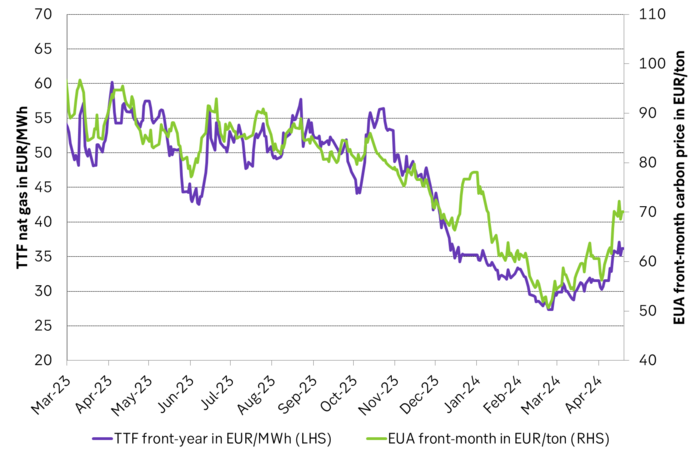
Front-month EUA price vs regression function of EUA price vs. nat gas derived from data from Apr to Nov last year.
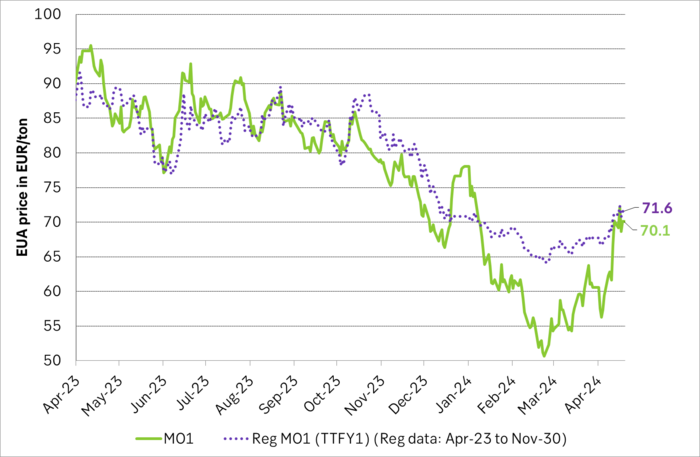
The EUA price vs the UKA price. Correlations previously, but not much any more.
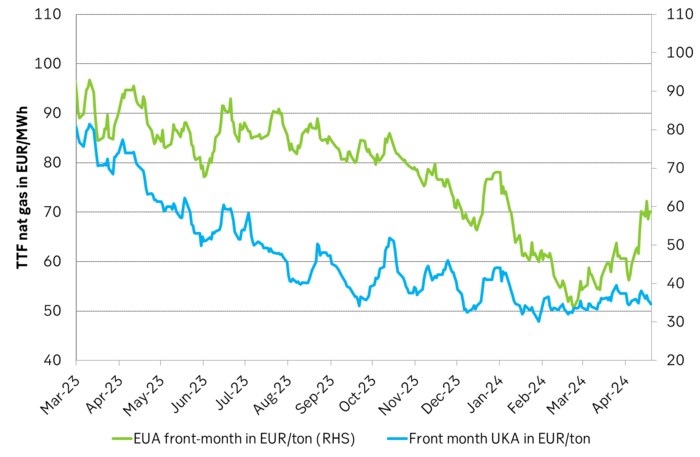
Forward German power prices versus clean cost of coal and clean cost of gas power. Coal is totally priced out vs power and nat gas on a forward 2026/27 basis.

Forward price of EUAs versus technical level where dynamical coal to gas flex typically takes place. EUA price for 2026/27 is at a level where there is no longer any price dynamical interaction or flex between coal and nat gas. The EUA price should/could then start to be negatively correlated to nat gas.

Forward EAU price vs. BNEF base model run (look for new update will come in late April), SEB’s EUA price forecast.
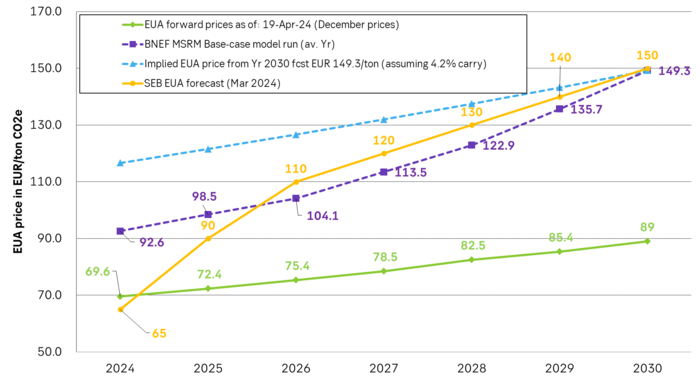
-

 Nyheter3 veckor sedan
Nyheter3 veckor sedanGuldpriset når nytt all time high och bryter igenom 2300 USD
-

 Nyheter4 veckor sedan
Nyheter4 veckor sedanLundin Mining får köprekommendation av BMO
-

 Nyheter3 veckor sedan
Nyheter3 veckor sedanCentralbanker fortsatte att köpa guld under februari
-

 Nyheter3 veckor sedan
Nyheter3 veckor sedanUSAs stigande konsumtion av naturgas
-

 Nyheter3 veckor sedan
Nyheter3 veckor sedanKakaomarknaden är extrem för tillfället
-

 Nyheter3 veckor sedan
Nyheter3 veckor sedanHur mår den svenska skogsbraschen? Två favoritaktier
-

 Nyheter4 veckor sedan
Nyheter4 veckor sedanBoliden på 20 minuter
-

 Nyheter3 veckor sedan
Nyheter3 veckor sedanBetydande underskott i utbudet av olja kan få priset att blossa upp


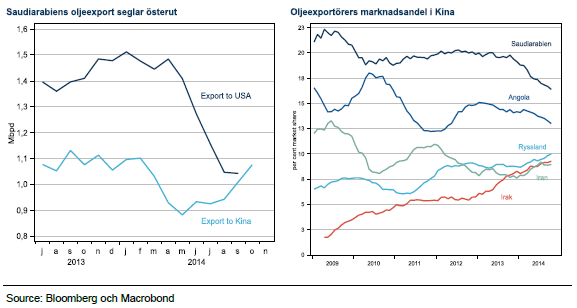






Kalle
29 november, 2014 vid 09:27
skifferoljebolagen har ju inte genererat någon cashflow vid oljepriser runt 100 usd/fat – därför verkar det fullständigt osannolikt att de skulle klara denna prisnivå någon längre tid.
däremot försöker man hålla humöret uppe hos investerare och talar gärna om hur billig produktionen är – medan cashflow talar ett helt annat språk…